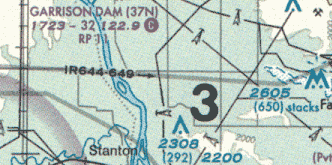FAAの筆記試験(Knowledge Exam)について。 : Privateの筆記試験について : PVTの問題へ : IFR、筆記の解説 : IFR問題へ
Private Pilot : 2007年 Airman Knowledge Test Question (Written Exam)
131.
The normal radius of the outer area of Class C airspace is
A) 5 nautical miles.
B) 15 nautical miles.
C) 20 nautical miles.
解説 と 和訳 があります。
132.
The vertical limit of Class C airspace above the primary airport is normally
A) 1,200 feet AGL.
B) 3,000 feet AGL.
C) 4,000 feet AGL.
解説 と 和訳 があります。
133.
(Refer to figure 24, area 3.) What is the floor of the Savannah Class C airspace at the shelf area (outer circle)?
A) 1,300 feet AGL.
B) 1,300 feet MSL.
C) 1,700 feet MSL.
Figure 24へ 別に解説 と 和訳 があります。

Figure 24, Area 3
134.
A non-tower satellite airport, within the same Class D airspace as that designated for the primary airport, requires radio communications be established and maintained with the
A) satellite airport's UNICOM.
B) associated Flight Service Station.
C) primary airport's control tower.
135.
The lateral dimensions of Class D airspace are based on
A) the number of airports that lie within the Class D airspace.
B) 5 statute miles from the geographical center of the primary airport.
C) the instrument procedures for which the controlled airspace is established.
136.
(Refer to figure 23, area 3.) The vertical limits of that portion of Class E airspace designated as a Federal Airway over Magee Airport are
A) 1,200 feet AGL to 17,999 feet MSL.
B) 700 feet MSL to 12,500 feet MSL.
C) 7,500 feet MSL to 17,999 feet MSL.
Figure 23へ

Figure 23、 Area 3
137.
(Refer to figure 22, area 3.) What type military flight operations should a pilot expect along IR 644?
A) IFR training flights above 1,500 feet AGL at speeds in excess of 250 knots.
B) VFR training flights above 1,500 feet AGL at speeds less than 250 knots.
C) Instrument training flights below 1,500 feet AGL at speeds in excess of 150 knots.
Figure 22へ

Figure 23, Area 3
138.
An ATC radar facility issues the following advisory to a pilot flying on a heading of 090°:
'TRAFFIC 3 O'CLOCK, 2 MILES, WESTBOUND...'
Where should the pilot look for this traffic?
A) East.
B) South.
C) West.
139.
Responsibility for collision avoidance in an alert area rests with
A) the controlling agency.
B) all pilots.
C) Air Traffic Control.
140.
(Refer to figure 27, area 2.) What hazards to aircraft may exist in areas, such as Devils Lake East MOA?
A) Unusual, often invisible, hazards to aircraft, such as artillery firing, aerial gunnery, or guided missiles.
B) Military training activities that necessitate acrobatic or abrupt flight maneuvers.
C) High volume of pilot training or an unusual type of aerial activity.
Figure 27へ
Private Pilot Knowledge Test (Private Written Exam) 05/23/2007 :
2008年の問題へ